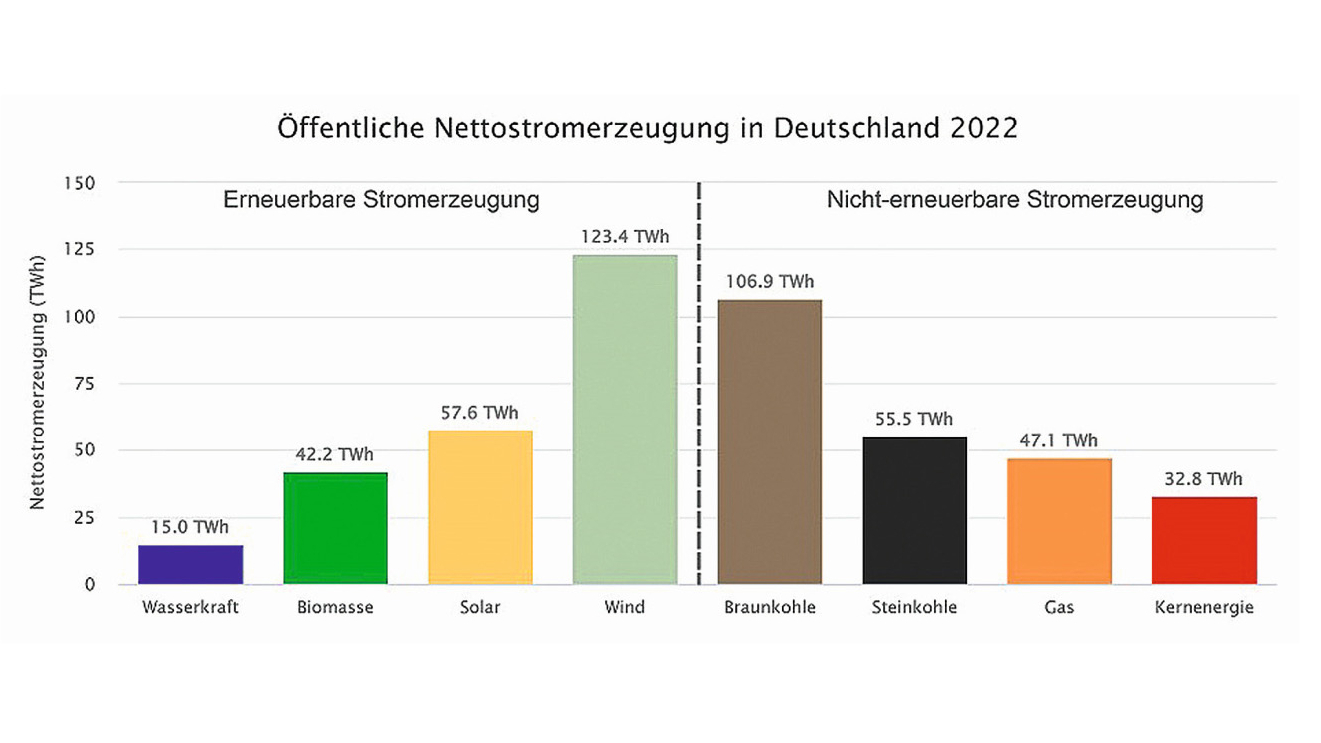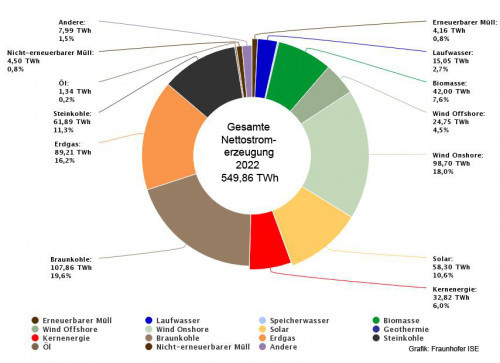The year 2022 was characterized by extreme prices and strong growth in renewable energies, according to the annual electricity analysis for Germany by the Fraunhofer Institute for Solar Energy Systems ISE. Electricity trade with neighboring countries also picked up.
The share of renewable energies in net electricity generation, i.e. the electricity mix that actually comes out of the socket, was 49.6% and their share of the load was 50.3%. Only photovoltaics achieved the expansion targets set by the German government and was able to increase its contribution to electricity generation by 19 %. German photovoltaic systems generated around 58 TWh in 2022, of which around 53 TWh was fed into the public grid and 5 TWh was consumed by the country itself. The addition of 6.1 GW of EEG systems increased the installed capacity to approx. 66 GW (as of November). Thanks to the expansion and the sunny weather, solar power generation increased by 19% compared to 2021. From April to August and in October, the monthly electricity generation of photovoltaic systems was higher than that of hard coal-fired power plants and from March to September higher than that of gas-fired power plants. For onshore wind, 2022 was an average year, while offshore wind was below average. Wind onshore and offshore together produced around 123 TWh, after 112 TWh in 2021. Most electricity was generated from wind energy, followed by lignite, solar, hard coal, natural gas, biomass, nuclear power and hydropower. The share of onshore wind power production amounted to approx. 99 TWh and offshore production to approx. 25 TWh, of which approx. 21 TWh was generated in the North Sea and 4 TWh in the Baltic Sea.
Expansion of wind power remains weak
The expansion of both onshore and offshore wind was again very weak: at the end of November 2022, the installed capacity of onshore wind was 58 GW (up 2.1 GW on 2021) and that of offshore wind was 8.1 GW (up 0.3 GW). Together, solar and wind energy plants produced around 181 TWh in 2022, around 21 TWh more than in 2021. At 16 TWh, hydropower generation was significantly lower than in 2021 (19 TWh) due to the hot and dry summer. At 42.2 TWh, biomass was slightly above the previous year's figure. Installed capacity has hardly changed. In total, renewable energy sources produced around 244 TWh in 2022, around 7.4% more than in the previous year (227 TWh). Their share of public net electricity generation rose to 49.6% (2021: 45.6%) and their share of load was50.3%.
Total net electricity generation (figure below) includes net public electricity generation and own generation by industrial and commercial enterprises (mainly with gas). The share of renewables in total net electricity generation, including power plants in the "manufacturing, mining and quarrying industries", is around44.5 %.
Comeback of coal-fired power generation
Russia's attack on Ukraine in February 2022 led to major upheavals on the energy markets and a slump in natural gas imports from Russia. In Europe, this combined with the outage of half of the French nuclear power plant fleet led to high electricity prices. This shortfall was partially offset by an increase in coal-fired power generation, which rose for the third year in a row following a downward trend since 2013. Lignite rose to 107 TWh (2021: 99 TWh), hard coal to 56 TWh (2021: 47 TWh). In contrast, the use of natural gas to generate electricity fell from 52 TWh to 47 TWh. Due to the shutdown of the three nuclear power plants Grohnde, Gundremmingen C and Brokdorf, generation from nuclear power fell by 50 % from 65 TWh to 33 TWh.
Strong increase in export surplus
In 2022, an export surplus of around 26 TWh was achieved in electricity trading (planned or scheduled), 9 TWh more than in 2021. The majority of exports went to Austria (16.0 TWh) and France (15.3 TWh), followed by Switzerland (6.6 TWh) and Luxembourg (3.9 TWh). Germany imported electricity from Denmark (10.3 TWh), Norway (3.7 TWh ) and Sweden (3.1 TWh). The average volume-weighted day-ahead exchange electricity price was EUR 230.58/MWh or 23.058 cents/kWh. This is approximately 2.5 times the price in 2021 (EUR 93.35/MWh) and 6.3 times the price in 2019 (EUR 36.65/MWh).



